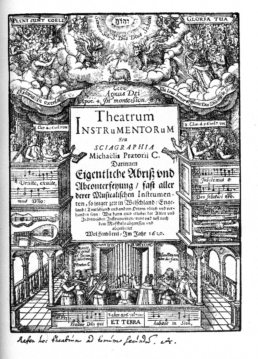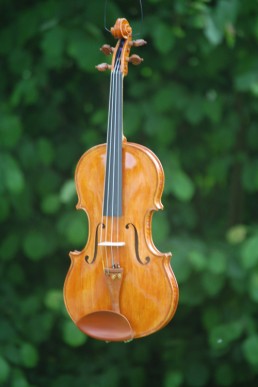
The Octet
In 1957 Carleen Hutchins decided to help Henry Brandt on his request to develop a set of eight matched instruments with the tonal character and power of the violin, covering the entire range of written music. It was a quest wich took her 30 years. Each instrument has its two main resonances within a semitone of the tuning of its open middle strings, on the same place as a classical violin. The result is beyond a doubt musically succesful.
An often heard comment: “One must hear the new instruments to believe such sounds are possible from strings.”
In 1619 Michael Praetorius described similar instruments in his Syntagma Musica, Bach composed music for some of them, Léo Sir and Frederick Dautrich made them. Beginning 2000 Joris Wouters built the entire octet in his shop.

Violino Piccolo
The main problem with the violino piccolo has been to get the frequencies of body and cavity resonances high enough and still keep the mensure long enough for a player to finger consecutive semitones without having to slide his fingers around.
At one point it was considered to resort to a three-stringed instrument, as was indicated by Michael Praetorius in 1619.
A string material of requisite tensile strength to reach the high E at 1320 Hz was finally found in carbon rocket wire.
Being the smallest one of the octet, the treble is tuned one octave above the violin. Do not be mistaken by it’s size however, this is not a childs instrument. On the contrary, it takes a skillful player to let it sing it’s wonderful, bright, high tones.

Soprano
Tuned an octave above the alto, the soprano was designed to have as large a plate area as possible, with resulting shallow ribs and fairly large f holes to raise the cavity resonance to the desired G at 392 Hz.The mensure is as long as possible for playing convenience.
J. S. Bach wrote for an instrument in this tuning, which Sir George Grove describes in Grove’s dictionary:
“The violino piccolo is a small violin, with strings of a length suitable to be tuned a fourth above the ordinary violin. It existed in its own right for playing notes in a high compass… It survives as the ‘threequarter violin’ for children. Tuned like a violin, it sounds wretched, but in its proper pitch it has a pure tone color of its own, for which the high positions on the ordinary violin gave no substitute.”

Mezzo violin
Tuned the same as the violin, the present mezzo with a body length of 38.2 cm was added to the new violin family when musicians found that even an excellent concert violin did not have the power to match the other members of the group.
According to scaling theory this instrument, is made 1.07 times as long as the violin, has more power than the normal violin and seems most satisfactory.
It has the normal violin resonance placement, yet it is adjusted to have conventional violin mensure for the player.
In fact several musicians have indicated that it may be the violin of the future.

Alto violin
Tuned the same as a viola, this is the instrument that will most likely shake up musicians. Since its size takes the instrument from under the chin to a cello position.
Yoyo Ma recorded Bartok’s concerto for viola on it. An outstanding performance for which he was awarded a grammy.
The greatest difficulty with the alto is that it puts the viola player at a distinct disadvantage by taking the viola from under his chin and setting it on a peg, cello fashion on the floor.
The greatest advantage is the increase in power and overall tone quality.
Leopold Stokowski’s comment: That is the sound I have always wanted from the violas in my orchestra. No viola has ever sounded like that before. It fills the whole hall.

Tenor violin
The body length of the tenor was redeveloped from the Dautrich vilon with strings as long as possible for convenient cello fingering. Many musicians have been impressed with its potential in ensemble, as well as in solo work. Musicians are usually surprised to find that it is not a small cello but a large violin, tuned an octave lower.
The Grove Dictionary for musical instruments says the following: “The gradual suppression of the tenor instrument in the 18th century was a disaster; neither the lower register of the viola nor the upper register of the violoncello can give its effect. It is as though all vocal part music were sung without any tenors, whose pasts were distributed between the basses and contraltos! It is essential for 17th century concerted music for violins and also for some works by Handel and Bach and even later part-writing. In Purcell’s Fantasy on One Note the true tenor holds the sustained C… The need for a real tenor voice in the 19th century is evidenced by the many abortive attempts to create a substitute.”

Baritone violin
The baritone is tuned as a cello. The body resonance is nearly three semitones lower than projected, and this departure probably accounts for the somewhat bass-like quality on the low C 65.4 Hz string.
The baritone’s strings are 0.75 inch (1.8 cm) longer than those of the traditional cello.
One concert cellist once said after playing it for half an hour, “You have solved all the problems of the cello at once. But I would like a conventional cello string length.”
Thus a redesign of this instrument is desirable by shortening the body length a little. This redesign would raise the frequency of the body resonance and at the same time make a shorter string possible.

Bassetto violin
Bass players have found the bassetto has a most desirable singing quality and extreme playing ease. It has proved most satisfactory in both concert and recording sessions.
Silvio Dalla Torre, double bass professor at the Universityof Music and Drama in Rostock/Germany, comments on the bassetto that I made for him:
“I have been testing some days with my piano accompanist. The bassetto has proved itself in every situation.I also tried it in a concerthall: equal sound in all positions from the lowest up to the highest note. It has no trouble in talking back to the grand piano. The timbre is silver, warm, clear, very overtone rich and bright. I have never played a better bass!”

Bass violin
The bass is tuned as double bass.
Total height is 210 cm in height; yet it has been possible to get the string length well within conventional bass measure at 110 cm, so that a player of average height has no trouble playing it except when he reaches into the higher positions near the bridge.
Its ease of playing and depth of tone delights all who plays or hears.
Henry Brant commented:”I have waited all my life to hear such sounds from a bass.”
La Corda bowed instruments. New handmade instruments,
set up, repairs and restauration.